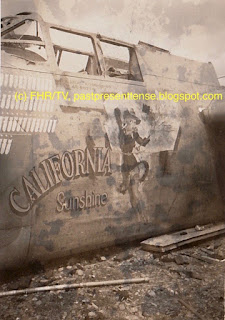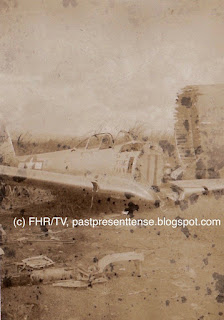Years ago, my mother and I were going through her parents’ items from when her father was in the U.S. Air Force, and among the papers were a number of photos of airplanes that, to me at the time, looked like they were WWII airplanes that had been shot down. (Why did I think they were WWII airplanes that had been shot down? Really only because I knew my grandfather was in WWII, and the airplanes either didn’t look whole or looked kind of shabby. Therefore, they MUST have been WWII wrecks, right?) I took three of the photos to keep for myself; two of them have good close-ups of the nose art, which have ladies in skimpy (or no) outfits. At the time, I didn’t know that was common, and was appalled that my grandfather would take a picture of a pornographic airplane. Some time after I found these pictures, we visited the Historic Flight Foundation on Paine Field in Everett, WA, where I saw other planes with women in skimpy (or no) outfits or named with innuendo, and that’s when I learned about naming your plane for ladies and having it decorated in a risqué manner. (And I tried very hard not to blush when the older-gentleman docent was talking about the Impatient Virgin?.)
 |
| The California Sunshine... at least she has clothes on |
But what are these planes in my grandfather’s photos? And where were these pictures taken? None of the photos are marked with any information (except the third photo, which is labeled as “What’s left of a Jap Zero”; despite the very washed out photo, I’m pretty sure that’s not a Japanese insignia on the main plane in the photo), or with any clue as to why my grandfather took them. I chalked it up to that attitude of “I’ll always remember what this was and where I was,” as well as not realizing someone else might look at the pictures after you’re gone. (And that led me to remind myself: Always label your photos, even if you think you’ll remember the details. Someday you might not remember, or someone else may be looking at them.) So I put them in a box of photos with other photos from my mother’s family, and moved on.
 |
| "What's left of a Jap Zero"... but that's not a Japanese insignia |
Last night, while cleaning out my closet, I was going through that box and found the pile of family photos. Surprise, surprise, there are those three pictures of WWII-looking airplanes. Between the time I snagged those photos for myself and now, I’ve worked at (and been laid off from) a military aviation museum, so when I looked at those photos again yesterday, I was even more intrigued than I was when I first saw them. It was no longer only “I wonder what that plane was and I wonder where my grandfather was when he took this picture…if he’s even the one who took it,” and being curious about the grandfather I never met; it was now also “Ooh, what is this? What type of plane is it? Did we have one at the museum? What’s its story? When was it built?” In the intervening years, too, the internet has grown more, I’ve visited and researched the collections of other aviation museums aside from the one I worked at, I know now how to locate serial numbers on an airplane, and I’ve learned that there’s a large community of military aviation enthusiasts, and if you know where to look (Hello, Google!), you can find lots of information about WWII airplanes online. So, to Google I go!
I’m especially curious to find out where these pictures might have been taken and what types of planes each of these were (I’m not sure I’m going to be able to figure out anything about the so-called Zero, since the original picture is so washed out and I don’t have that aviation knowledge to be able to look at a plane’s frame and know exactly what type it is), but also what their missions or purposes were, and what happened to the crews. Since I first found the pictures, I’ve also learned that just because a plane looks shabby doesn’t mean it’s been shot down: it could simply have been decommissioned or deemed unairworthy.
My mother made a scrapbook of family pictures while doing genealogy, and the book includes a couple of my grandfather’s pictures of airplanes on a runway in Papua New Guinea during WWII. I always meant to ask the mechanics I worked with at the museum what kind of airplanes they were, but I never got brave enough. More Advice From Tiffany: Don’t let the opportunity slip away. If it’s important enough to think about it, act on it before it’s too late. I now have five pictures in my possession (three loose, two in a scrapbook) that are a major piece of U.S. history, and I’m going to have to rely on my research skills and what I can find on the internet to give me even a scrap of what could have been a fascinating piece of family history.
So, with pictures and magnifying glass in hand, I shall take to the internet to find out what bits of American and family history I have in my possession! Off we go into the wild blue yonder, Nancy Drew!

